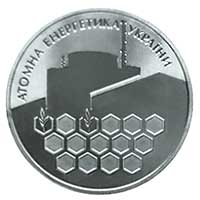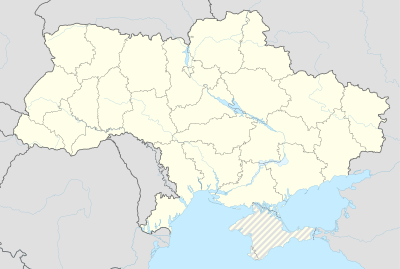Nuclear power in Ukraine
This article needs to be updated. (March 2013) |

Ukraine operates four nuclear power plants with 15 reactors located in Volhynia and South Ukraine.[1] The total installed nuclear power capacity is over 13 GWe,[2] ranking seventh in the world in 2016.[1] Energoatom, a Ukrainian state enterprise, operates all four active nuclear power stations in Ukraine.[3] In 2014, nuclear power supplied 49.4% of Ukraine's electricity production of 168 TWh.
Overview[]



Ukraine relies to a large extent on nuclear power. The largest nuclear power plant in Europe, the Zaporizhzhia Nuclear Power Plant, is located in Ukraine. In 2006, the government planned to build 11 new reactors by the year 2030, which would almost double the current amount of nuclear power capacity.[4] Ukraine's power sector is the twelfth-largest in the world in terms of installed capacity, with 54 gigawatts (GW).[5] Renewable energy still plays a very modest role in electrical output; in 2005 energy production was met by the following sources: nuclear (47 percent), thermal (45 percent), hydroelectric and other (8 percent).[4]

The Chernobyl disaster was a nuclear accident that occurred on 26 April 1986 at the Chernobyl Nuclear Power Plant in Ukraine. An explosion and fire released large quantities of radioactive contamination into the atmosphere, which spread over much of Western USSR and Europe. It is considered the worst nuclear power plant accident in history, and is one of only two classified as a level 7 event on the International Nuclear Event Scale (the other being the Fukushima Daiichi nuclear disaster).[6] The battle to contain the contamination and avert a greater catastrophe ultimately involved over 500,000 workers and cost an estimated 18 billion rubles, crippling the Soviet economy.[7]
Ukraine used to receive its nuclear fuel exclusively from Russia by the Russian company TVEL. Since 2008 the country also gets nuclear fuel from Westinghouse.[8] Since 2014 Westinghouse's share of imports grew to more than 30% in 2016 due to strong social disapproval of any economic relations with Russia after Crimea annexation.[1] In 2018 Westinghouse's contract to supply VVER fuel was extended to 2025.[9] Oil and natural gas provide the remainder of the country's energy; these are also imported from the former Soviet Union.
In 2011 Energoatom began a project to bring safety into line with international standards at an estimated cost of $1.8 billion, with a target completion date of 2017. In 2015 the completion date was put back to 2020, due to financing delays.[10] In 2015 some government agencies made corruption allegations against Energoatom, with concerns raised by Prime Minister Arseniy Yatsenyuk.[11] In March 2016, Energoatom's assets and bank accounts were frozen by Ukrainian courts over allegedly unpaid debts; Energoatom appealed the decision, but the frozen finances led to contractual breaches.[12] In June 2016 its bank accounts were unfrozen.[13]
In February 2018 Ukraine secured $250 million of U.S. funding to build a spent nuclear fuel storage facility, which will avoid the need to ship spent nuclear fuel to Russia.[14]
In March 2018 Energoatom stated that electricity prices were too low to cover the cost of new nuclear fuel, and called for a price increase.[15]
In 2019 Energoatom and Turboatom signed a five year contract to modernise condensers and turbines at a number of Ukrainian nuclear power plants.[16]
On 4 December 2019, Ukraine's government appointed Pavlo Pavlyshyn as acting head of Energoatom. During January 2020 Energoatom discussed eight legislative bills with the chairman of the Ukrainian parliament subcommittee on nuclear energy and safety, aimed at meeting international obligations and standards, and the financial stabilisation of Energoatom.[17]
In August 2021 Energoatom and Westinghouse signed a contract for construction of Westinghouse AP1000 reactors to replace the unfinished blocks in Khmelnitskyi power plant.[18]
Uranium mining[]
In 2005 there were 17 deposits on the state balance account.[19] Three of them Vatutine, Central, and Michurinske were being developed, while an ore enrichment factory was being built at Novokostiantyniv.[19] Number of deposits are exhausted (i.e. Devladove, Zhovtorichenske, Pershotravneve, Bratske).[20][19]
Activists have been long alerting about Dnipro Chemical Plant in Kamianske, which is a Soviet-times military uranium processing facility that consists of industrial buildings, equipment containing uranium waste as well as large landfills where tailings were stored. Small scale soil, water and dust leaks have been documented from the facility, but apart from securing the perimeter not much has been done to properly secure the plant.[21]
List of reactors[]
All of Ukraine's RBMK reactors (the type involved in the 1986 Chernobyl disaster) were located at the Chernobyl Nuclear Power Plant. All of the reactors there have been shut down, leaving only the much safer VVER reactors operating in the country.[1] Three of the reactors listed were built in post-independence Ukraine, with the first one of these being constructed in 1995; the other sixteen reactors the country inherited from the Soviet Union.
Active plants with power generating capabilities[]
| Name | Location | Type | Capacity, MWe | Operational | Notes |
|---|---|---|---|---|---|
| Khmelnytskyi | Netishyn | VVER | 1000 | 1987- | |
| VVER | 1000 | 2004- | |||
| VVER | 1100 | construction | started in 1986, to be replaced by AP1000 | ||
| VVER | 1100 | construction | started in 1987, to be replaced by AP1000 | ||
| Rivne | Varash | VVER | 440 | 1980- | |
| VVER | 440 | 1981- | |||
| VVER | 1000 | 1986- | |||
| VVER | 1000 | 2004- | |||
| South Ukraine | Yuzhnoukrainsk | VVER | 1000 | 1982- | |
| VVER | 1000 | 1985- | |||
| VVER | 1000 | 1989- | |||
| VVER | 1000 | construction | started in 1987 is frozen | ||
| Zaporizhzhia | Enerhodar | VVER | 1000 | 1984- | largest nuclear power plant in Europe |
| VVER | 1000 | 1985- | |||
| VVER | 1000 | 1986- | |||
| VVER | 1000 | 1987- | |||
| VVER | 1000 | 1989- | |||
| VVER | 1000 | 1995- | |||
| Total | Ukraine | VVER | 13819 | 1981 (1978)- |
Research reactors[]
| Name | Location | Type | Capacity, MWe | Operational | Notes |
|---|---|---|---|---|---|
| Sevastopol University | Sevastopol | 100 | 1967- | ceased by the Russian Federation | |
| Institute for Nuclear Research NASU | Kyiv | 10 | 1960- | ||
| Kharkiv Institute of Physics and Technology | Kharkiv | The source of neutrons | 2016- |
Unfinished and closed plants[]

| Name | Location | Type | Capacity, MWe | Operational | Notes |
|---|---|---|---|---|---|
| Chernobyl NPP | Pripyat | RBMK | 1000 | 1977-1996 | |
| RBMK | 1000 | 1978-1991 | stopped after the 1991 accident | ||
| RBMK | 1000 | 1981-2000 | |||
| RBMK | 1000 | 1984-1986 | exploded in the Chernobyl accident | ||
| RBMK | 1000 | construction | started in 1981, it was frozen 1987 | ||
| RBMK | 1000 | construction | started in 1981, it was frozen 1987 | ||
| Crimean NPP | Shcholkine | VVER | 950 | construction | started in 1982, it was frozen 1989 |
| VVER | 950 | construction | started in 1983, it was frozen 1989 | ||
| VVER | 950 | plans | |||
| VVER | 950 | plans | |||
| Odesa NTEC | Teplodar | VVER | 940 | preparations | ceased in 1989 |
| VVER | 940 | preparations | ceased in 1989 | ||
| Kharkiv NTEC | Birky | VVER | 940 | preparations | started in 1986, it was frozen 1989 |
| VVER | 940 | preparations | started in 1986, it was frozen 1989 | ||
| VVER | 940 | plans | |||
| VVER | 940 | plans | |||
| Chyhyryn NPP | Orbita | VVER | 1000 | plans | scratched in 1989 |
| VVER | 1000 | plans | scratched in 1989 | ||
| VVER | 1000 | plans | scratched in 1989 | ||
| VVER | 1000 | plans | scratched in 1989 |
Anti-nuclear movement[]

This section is empty. You can help by . (October 2019) |
Pro-nuclear movement[]
This section is empty. You can help by . (November 2020) |
See also[]
- Energoatom (Ukraine)
- Nuclear energy policy in general
- Electricity sector in Ukraine
- List of power stations in Ukraine
- List of Chernobyl-related articles
References[]
- ^ a b c d e Nuclear fuel imports from Sweden account for 41.6% in H1, balance from Russia, UNIAN (22 August 2016)
- ^ "PRIS - Country Details: Ukraine". Retrieved 8 January 2016.
- ^ Energoatom chief Kim overstepped his powers when signing contract, failed to show up for questioning, says interior minister, Interfax-Ukraine (12 June 2013)
- ^ a b "Nuclear Power in Ukraine". World Nuclear Association. Retrieved 22 December 2007.
- ^ "Ukraine". Energy Information Administration (EIA). US government. Archived from the original on 15 October 2009. Retrieved 22 December 2007.
- ^ Black, Richard (12 April 2011). "''Fukushima: As Bad as Chernobyl?''". Bbc.co.uk. Retrieved 20 August 2011.
- ^ From interviews with Mikhail Gorbachev, Hans Blix and Vassili Nesterenko. The Battle of Chernobyl. Discovery Channel. Relevant video locations: 31:00, 1:10:00.
- ^ "Westinghouse and Ukraine's Energoatom extend nuclear fuel contract". Archived from the original on 23 April 2014. Retrieved 23 April 2014.CS1 maint: bot: original URL status unknown (link)
Westinghouse CEO: We are ready to put our fuel in all of Ukraine's NPP, UNIAN (28 October 2015) - ^ "Ukraine signs new fuel contract with Westinghouse". Nuclear Engineering International. 1 February 2018. Retrieved 3 February 2018.
- ^ "Ukraine aims to complete safety upgrade program in 2020". World Nuclear News. 7 August 2015. Retrieved 10 August 2015.
- ^ "Energoatom chief recalls highs and lows of first half-year". World Nuclear News. 12 August 2015. Retrieved 16 June 2016.
- ^ "Continued Ukraine-Russia tensions over fuel". Nuclear Engineering International. 7 June 2016. Archived from the original on 13 February 2019. Retrieved 16 June 2016.
- ^ "Energoatom's accounts unblocked". Interfax-Ukraine. 29 June 2016. Retrieved 21 February 2017.
- ^ "Ukraine secures US funding for storage facility". World Nuclear News. 15 February 2018. Retrieved 19 February 2018.
- ^ "Energoatom counts cost of regulatory changes". World Nuclear News. 19 March 2018. Retrieved 20 March 2018.
- ^ "Energoatom, Turboatom sign contract for modernizing Ukraine's nuclear power plants". Kyiv Post. 27 August 2019. Retrieved 3 September 2019.
- ^ "Ukraine assesses legislation to support nuclear sector". World Nuclear News. 14 January 2020. Retrieved 14 January 2020.
- ^ Company, Westinghouse Electric. "Energoatom and Westinghouse Advance Clean Energy Throughout Central and Eastern Europe". info.westinghousenuclear.com. Retrieved 1 September 2021.
- ^ a b c About economic feasibility to attract investments in exploration and development of uranium deposits in Ukraine. Ukrainian geological projects.
- ^ Sieroi, S. Uranium plus gold, is that a solution to crisis? "Den". 22 May 1998.
- ^ "In central Ukraine, a city's future is overshadowed by a radioactive neighbour". openDemocracy. Retrieved 1 September 2021.
External links[]
- Nuclear power in Ukraine
- Industry in Ukraine
- Energy in Ukraine
